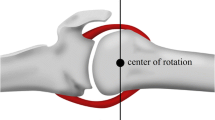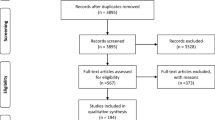Abstract
Purpose
The outcome of flexor tendon surgery is negatively affected by the formation of adhesions which can occur during the healing of the tendon repair. In this experimental study, we sought to prevent adhesion formation by wrapping a collagen-elastin scaffold around the repaired tendon segment.
Methods
In 28 rabbit hind legs, the flexor tendons of the third and fourth digits were cut and then repaired using a two-strand suture technique on the fourth digit and a four-strand technique on the third digit. Rabbits were randomly assigned to study and control groups. In the control group, the operation ended by closing the tendon sheath and the skin. In the study group, a collagen-elastin scaffold was wrapped around the repaired tendon segment in both digits. After 3 and 8 weeks, the tendons were harvested and processed histologically. The range of motion of the digits and the gap formation between the repaired tendon ends were measured. The formation of adhesions, infiltration of leucocytes and extracellular inflammatory response were quantified.
Results
At the time of tendon harvesting, all joints of the operated toes showed free range of motion. Four-strand core sutures lead to significantly less diastasis between the repaired tendon ends than two-strand core suture repairs. The collagen-elastin scaffold leads to greater gapping after 3 weeks compared to the controls treated without the matrix. Within the tendons treated with the collagen-elastin matrix, a significant boost of cellular and extracellular inflammation could be stated after 3 weeks which was reflected by a higher level of CAE positive cells and more formation of myofibroblasts in the αSMA stain in the study group. The inflammatory response subsided gradually and significantly until the late stage of the study. Both the cellular and extracellular inflammatory response was emphasized with the amount of material used for the repair.
Conclusion
The use of a collagen-elastin matrix cannot be advised for the prevention of adhesion formation in flexor tendon surgery, because it enhances both cellular and extracellular inflammation. Four-strand core sutures lead to less gapping than two-strand core sutures, but at the same time, the cellular and extracellular inflammatory response is more pronounced.







Similar content being viewed by others
References
Dinopoulos HT, Boyer MI, Burns ME, Gelberman RH, Silva MJ (2000) The resistance of a four- and eight-strand suture technique to gap formation during tensile testing: an experimental study of repaired canine flexor tendons after 10 days of in vivo healing. J Hand Surg Am 25:489–498. doi:10.1053/jhsu.2000.6456
Miller B, Dodds SD, deMars A, Zagoreas N, Waitayawinyu T, Trumble TE (2007) Flexor tendon repairs: the impact of Fiberwire on grasping and locking core sutures. J Hand Surg Am. 32:591–596. doi:10.1016/j.jhsa.2007.03.003
Waitayawinyu T, Martineau PA, Luria S, Hanel DP, Trumble TE (2008) Comparative biomechanic study of flexor tendon repair using FiberWire. J Hand Surg Am 33:701–708. doi:10.1016/j.jhsa.2008.01.010
Le SV, Chiu S, Meineke RC, Williams P, Wongworawat MD (2012) Number of suture throws and its impact on the biomechanical properties of the four-strand cruciate locked flexor tendon repair with FiberWire. J Hand Surg Eur 37:826–831. doi:10.1177/1753193412447503
Chen J, WangK Katirai F, Chen Z (2014) A new modified Tsuge suture for flexor tendon repairs: the biomechanical analysis and clinical application. J Orthop Surg Res 9:136. doi:10.1186/s13018-014-0136
Cormac WJ, Sugrue C, Chan JC, Delgado L, Zeugolis D, Carroll SM, Kelly JL (2014) A barbed suture repair for flexor tendons: a novel technique with no exposed barbs. Plast Reconstr Surg Glob Open 7;2(10):e237. doi:10.1097/GOX.0000000000000203
Moriya T, Larson MC, Zhao C, An KN, Amadio PC (2012) The effect of core suture flexor tendon repair techniques on glinding resistance during cyclic motion and load to failure: a human cadaver study. J Hand Surg Eur 37:316–322. doi:10.1177/1753193411422793
Moriya K, Yoshizu T, Maki Y, Tsubokawa N, Narisawa H, Endo N (2015) Clinical outcomes of early active mobilization following flexor tendon repair using the six-strand technique: short- and long-term evaluations. J Hand Surg Eu 40:250–258. doi:10.1177/1753193414551682
Tang JB, Shi D, Zhang QG (1996) Biomechanical and histological evaluation of tendon sheath management. J Hand Surg Am 21:900–908. doi:10.1016/S0363-5023(96)80212-7
Wong JKF, Lui YH, Kapacee Z, Kadler KE, Ferguson MWJ, McGrouther DA (2009) The cellular biology oft flexor tendon adhesion formation. Am J Pathol 175:1938–1951. doi:10.2353/ajpath.2009.090380
Menderes A, Mola F, Tayfur V, Vayvada H, Barutcu A (2004) Prevention of peritendinous adhesions following flexor tendon injury with seprafilm. Ann Plast Surg 53:560–564. doi:10.1097/01.sap.0000134507.00053.1a
Bhavsar D, Shettko D, Tenenhaus M (2010) Encircling the tendon repair site with collagen-GAG reduces the formation of postoperative tendon adhesions in a chicken flexor tendon model. J Surg Res 159:765–771. doi:10.1016/j.jss.2009.10.010
Temiz A, Ozturk C, Bakunov A, Kara K, Kaleli T (2008) A new material for prevention of pertendinous fibrotic adhesions after tendon repair: oxidised regenerated cellulose (Interceed), an absorbable adhesion barrier. Int Orthop 32:389–394. doi:10.1007/s00264-007-0335-8
Akali A, Khan U, Khaw PT, McGrouther AD (1999) Decrease in adhesion formation by a single application of 5-fluorouracil after flexor tendon injury. Plast Reconstr Surg 103:151–158. doi:10.1097/00006534-199901000-0002
Tan V, Nourbakhsh A, Capo J, Cottrell JA, Meyenhofer M, O’Connor JP (2010) Effects of nonsteroidal anti-inflammatory drugs on flexor tendon adhesion. J Hand Surg Am 35:941–947. doi:10.1016/j.jhsa.2010.02.033
Ferguson REH, Rinker B (2006) The use of a hydrogel sealant on flexor tendon repairs to prevent adhesion formation. Ann Plast Surg 26:54–58. doi:10.1097/01.sap.0000181666.00492.0c
Hung LK, Fu SC, Lee YW, Mok TY, Chan KM (2013) Local vitamin C injection reduced tendon adhesion in a chicken model of flexor digitorum profundus tendon injury. J Bone Joint Surg Am 95:41–47. doi:10.2106/JBJS.K.00988
Bloemen MCT, van Leeuwen MCE, van Vucht NE, van Zuijlen PPM, Middelkoop E (2010) Dermal substitution in acute burns and reconstructive surgery: a 12-year follow-up. Plast Reconstr Surg 125:1450–1459. doi:10.1097/PRS.0b013e3181d62b08
Min JH, Yun IS, Lew DH, Roh TS, Lee WJ (2014) The use of Matriderm and autologeous sking graft in the treatment of full thickness skin defects. Arch Plast Surg 41:330–336. doi:10.5999/aps.2014.41.4.330
Choi JY, Kim SH, Oh GJ, Roh SG, Lee NH, Yang KM (2014) Management of defects on lower extremities with the use of Matriderm and skin graft. Arch Plast Surg 41:337–343. doi:10.5999/aps.2014.41.4.337
Hur GY, Seo DK, Lee JW (2014) Contracture of skin graft in human burns: effect of artificial dermis. Burns 40:1497–1503. doi:10.1016/j.burns.2014.08.007
Xie RG, Xue HG, Gu JH, Tan J, Tang JB (2005) Effects of locking area on strength of 2- and 4-strand locking tendon repairs. J Hand Surg Am 30:455–460. doi:10.1016/j.jhsa.2004.12.012
Barrie KA, Tomak SL, Cholewicki J, Wolfe SW (2000) The role of multiple strands and locking sutures on gap formation of flexor tendon repairs during cyclical loading. J Hand Surg Am 25:714–720. doi:10.1053/jhsu.2000.9414
Hirpara KM, Sullivan PJ, Raheem O, O’Sullivaan ME (2007) A biomechanical analysis of multistrand repairs with the Silfverskiöld peripheral cross-stitch. J Bone Joint Surg Br 89:1396–1401. doi:10.1302/0301-620X.89B10.19360
Dogramaci Y, Kalaci A, Atik E, Esen E, Altug M, Onel E, Koc A, Yanat AN (2009) Effects of a single application of extractum cepae on the peritendinous adhesion. An experimental study in rabbits. Ann Plast Surg 64:338–341. doi:10.1097/SAP.0b013e3181afa428
Güdemez E, Eksioglu F, Korkusuz P, Asan E, Gürsel I, Hasirci V (2002) Chondroitin sulphate-coated polyhydroxyethyl methacrylate membrane prevents adhesion in full-thickness tendon tears of rabbits. J Hand Surg Am 27:293–306. doi:10.1053/jhsu.2002.31161
Riccio M, Battiston B, Pajardi G, Corradi M, Passaretti U, Atzei A, Altissimi M, Vaienti L, Catalano F, Del Bene M, Fasolo P, Ceruso M, Luchetti R, Landi A (2010) Efficiency of Hyaloglide® in the prevention of the recurrence of adhesions after tenolysis of flexor tendons in zone II: a randomized, controlled, multicentre clinical trial. J Hand Surg Eu 35:130–138. doi:10.1177/1753193409342044
Kocaoglu B, Agir I, Nalbantoglu U, Karahan M, Türkmen M (2010) Effect of Mitomycin-C on post-operative adhesions in tendon surgery. J Bone Joint Surg 92:889–893. doi:10.1302/0301-620X.92B6
Wiig ME, Dahlin LB, Friden J, Hagberg L, Larsen SE, Wiklund K, Mahlapuu M (2014) PXL01 in sodium hyaluronate for improvement of hand recovery after flexor tendon repair surgery: randomized controlled trial. PLoS One 9(10):e110735. doi:10.1371/journal.pone.0110735
Lees VC, Warwick D, Gillespie P, Brown A, Akhavani M, Dewer D, Boyce D, Papanastasiou S, Ragoowansi R, Wong J (2014) A multicentre, randomized, double-blind trial of the safety and efficacy of mannose-6-phosphate in patients having zone II flexor tendon repairs. J Hand Surg Eur 40:1–13. doi:10.1177/1753193414553162
Cervelli V, Brinci L, Spallone D, Tati E, Palla L, Lucarini L, De Angelis B (2011) The use of MatriDerm® and skin grafting in post-traumatic wounds. Int Wound J 8:400–405. doi:10.1111/j.1742-481X.2011.00806.x
Wollina U, Meseg A, Weber A (2011) Use of a collagen-elastin matrix for hard to treat soft tissue defects. Int Wound J 8:291–296. doi:10.1111/j.1742-481X.2011.00785.x
Hinz B, Phan SH, Thannickal VJ, Prunotto M, Desmoulière A, Varga J, De Wever O, Mareel M, Gabbiani G (2012) Recent developments in myofibroblast biology: paradigms for connective tissue remodeling. Am J Pathol 180:1340–1355. doi:10.1016/j.ajpath.2012.02.004
Author information
Authors and Affiliations
Corresponding author
Ethics declarations
Conflict of interest
The authors declare no conflict of interest.
Rights and permissions
About this article
Cite this article
Wichelhaus, D.A., Beyersdoerfer, S.T., Gierer, P. et al. The effect of a collagen-elastin matrix on adhesion formation after flexor tendon repair in a rabbit model. Arch Orthop Trauma Surg 136, 1021–1029 (2016). https://doi.org/10.1007/s00402-016-2472-2
Received:
Published:
Issue Date:
DOI: https://doi.org/10.1007/s00402-016-2472-2




